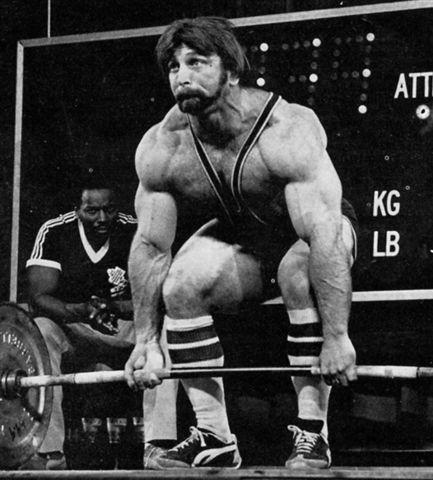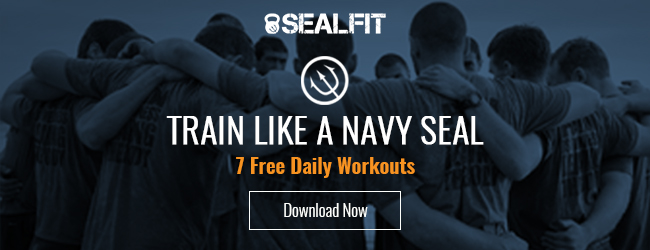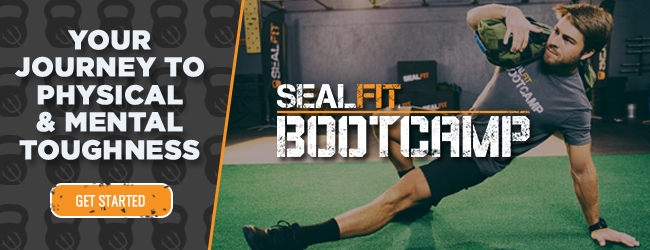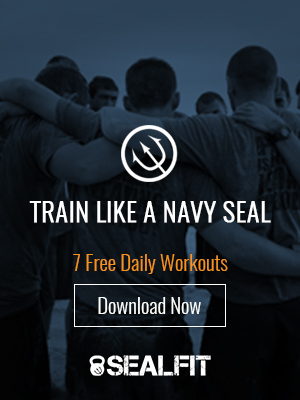Your body is a temple. And it starts on the ground floor.
Arms and abs might move magazine covers, but it’s seven billion lower bodies that move the world. From your feet to the small of your back rests the engine of peak performance, whether it’s just the activities of daily living or a matter of life and death. A well-developed lower body not only makes you stronger, it makes each step a little easier, saving precious cardio capacity for the long haul a SEALFIT athlete often finds him or herself in.
Strengthening your lower body also offers an unparalleled connection to mental toughness. Getting better at anything involves a little pain, but nowhere else do you carry it with you as much as training your legs. If you can walk back to a program that left you crawling away from it, you’re tougher than a lot of what life throws at you.
We’ve put together a list of six essential lower body exercises, most doable anywhere and adaptable with weight or technique tweaks to turn your weak spots into strengths. If you’re new or needing improvement in how you train your base of operations, the following moves will have you moving
Exercise 1: Squat
Working the lower body begins and ends with the squat. While it primarily works the glutes, the squat engages every muscle from the floor through to the small of the back. It’s also one of man’s most quintessential movements.
That doesn’t make it easy to avoid doing it all wrong. Just as all those muscles are strengthened by a great squat, a bad one leaves them imbalanced and at risk of injury. To perfect the standard squat, place your knees shoulder-width apart, keep your back straight, and drop your hips until they’re parallel with your knees, with your knees over your toes. Imagine yourself dropping into a chair, or use the corner of a box to simulate the real thing. Once you’re parallel, push off the floor, keeping your knees over your toes and driving your hips forward until you’re
The squat is also one of the easiest to modify. Once you’ve gotten the strength for 20 bodyweight-squat sets, consider adding weights for strength, or a faster interval for explosiveness. Whichever you decide, don’t let the numbers game interrupt your form. You may see short-term gains from letting your technique slip, but you’ll pay in a lower ceiling for gains even if the increased injury risk doesn’t come back to bite you.
Exercise 2: Lunge
Very few exercises work for lower-body stability quite like the lunge. An exaggeration of the act of stepping, lunges reinforce stability and provide functional strength you’ll use every day of your life.
Start with feet shoulder-width apart. Take a step forward, dropping your hips until both knees are are parallel with the hips, quads perpendicular to the shins. Push off with your forward foot and return to the original position, or bring the back leg parallel with the front. Repeat the action with the other leg. Once you’ve mastered the unweighted version, put a dumbbell in each hand for a challenge that will pay dividends with every step you take.
Exercise 3: Deadlift
If squats are lower body exercise at its most essential, the deadlift represents its most primal: something heavy is on the ground; go pick it up. And whether it’s a buddy’s couch, a line of scrimmage, or a person on the worst day of their life, a strong deadlift can get it moved.
To perform a traditional deadlift, grip the weight on the floor, with feet hip-width apart. Keeping your back absolutely straight, push through the floor with your feet, rising with the weight until you’re standing tall with the weight at waist level. (Warning: the deadlift targets vulnerable structures in your back more than any other lower body lift; bad form is not just counterproductive but potentially crippling.)
As your strength improves, your lower body will eventually outpace your grip strength; if you’re using an Olympic barbell, consider using an mixed grip (knuckles of each hand facing opposite directions) or letting the weight hang after your last rep as a negative rep for your forearms. The deadlift can also be modified with a plethora of bars and stances to target whatever muscle you’re looking to improve.
Exercise 4: Box Step Up
The box step up combines the stabilizing effect of the lunge with the pure strength of the squat. The form is perhaps the easiest of all: grab a box or other raised platform and step up on it. Bring your other foot to the top of the box. Control your downward descent until you’re back at the base of the box.
Once you’re capable of a string of steps, add weight for strength or consider jumps instead of steps for explosiveness.
Exercise 5: Bulgarian Split Squat
For next-level strength and stability, try the Bulgarian split squat. Place the top of one foot on a bench, then lower your knees and hips until the hips are parallel with the front knee. Push through the back heel to return to the original position.
Modify by adding more weight or increasing the drop angle.
Exercise 6: Heavy Sled Push
The sled is more than an essential lower body exercise. Here at SEALFIT, where the point of strength is to move heavy stuff far and long, it’s the ultimate piece of equipment. Barbells are wonderful in their place, but nothing tests brute strength like your irresistible force, an object engineered to be just shy of immovable, and an open lane to see who wins.
It’s just as useful for building the SEALFIT mentality. While it’s tempting to blow through the sled like the strongest man alive, the real gains come from keeping your form, and on a long push, that means keeping your cool. Control your breathing, keep your arms and back straight, and take controlled, careful steps. You’ll do better, you’ll get better, and you’ll be better prepared to use this skill in the wild for it.
One More Warning about Form
We’ll say it again because we can’t say it enough: maintain your form. These exercises are as dangerous if done incorrectly as productive when done right. You’re working out to make your life better, not move some extra numbers around. You can only get so much better sacrificing technique for a few more reps or pounds, and you won’t get any better at all nursing an injury for it.
Leave a Reply cancel reply
You must be logged in to post a comment.





No Comments